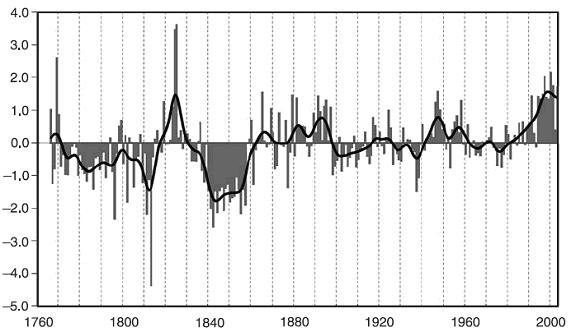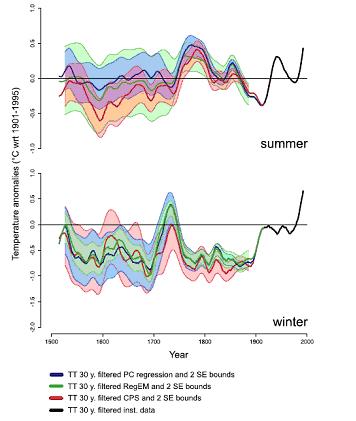First up is from a paper forthcoming in Meteorology and Atmospheric Physics by three scientists with the Atmospheric Physics Group in the Department of Civil and Environmental Engineering in Italy's University of Trento; the project was funded by the European Union through the European Regional Development Fund. The authors turn their attention to the northern European city of Verona, and they note a special opportunity there to reconstruct temperatures at a very high resolution going back 250 years. Andrighetti et al. note "after a careful search of both published and unpublished data from early observations, dispersed in various archives and libraries, under the guidance of historical information, data covering almost completely the period 1741 - 2006 were found, which provided the basis for the analysis presented in this paper." However, they state "After careful evaluation, measurements covering the period 1741-1768 appeared to be affected by too many discontinuities, gaps and possible ambiguities in the interpretation of data." They conducted many statistical tests on the remaining 1769-2006 data, and in the end, they were highly confident that the resulting time series was reasonably accurate.
The figure below (Figure 1) reveals the annual temperature anomalies, relative to a 1961-1990 "normal" period from 1769 to 2006. The global warming crusade would immediately point to the 1.5ºC warming from 1975 to 2006 as evidence of the human impact on climate. However, the authors of the paper were quick to point out that the three warmest years were 1828, 1827, and 1772! We also note that a warming of nearly 3ºC occurred from 1810 to 1825 while of warming of over 2ºC occurred from 1840 to 1865. The record from Verona shows us that very warm years occurred long before the great buildup of greenhouse gases and periods in the past have experienced far more warming that what has been observed in recent decades.

Our next history lesson from Europe comes from a recent paper published in Geophysical Research Letters by three scientists with the Oeschger Centre for Climate Change Research and Institute of Geography, Climatology and Meteorology at Switzerland's University of Bern. Riedwyl et al. reveal that "This work has been supported by the Swiss National Science Foundation (SNSF) through its National Center of Competence in Research on Climate." We at World Climate Report favor "Competence in Research on Climate," and we hope this phenomenon spreads rapidly through the discipline!
Anyway, Riedwyl et al. collected the gridded temperature record for Europe over the period 1901 to 1995; the "predictors, i.e., the proxy data consist of a combination of early instrumental temperature records, documentary proxy evidence, ice core- and sea ice data, albeit with some additional information that has become later available (tree ring series and grape harvest dates)." They used a variety of statistical approaches to link the variance in the proxy data to the instrumental temperature record with the results allowing for estimates of surface temperatures in the past given the proxy data.
The figure below (Figure 2) shows the various reconstructions for summer and winter extending back until 1500 AD. The global warming advocates will immediately point to recent warming in both seasons, but we at World Climate Report and the authors of the article are particularly impressed with the warming in the past. Riedwyl et al. note "For summer the three reconstruction results agree on pronounced positive anomalies in the late 18th century." Furthermore, for winter "results show distinctly positive temperature anomalies for the mid 18th century." Once again, we find that nothing all that unusual is being observed in the most recent period, and indeed, conditions were as warm or warmer in the past, and long before the buildup of greenhouse gases.

Our third lesson regarding European climate comes from an article published in Geomorphology by a team of scientists from Israel and Spain. They turned their attention to the Gardon River in southern France; the river has a special place in the greenhouse debate given an extreme flood that occurred in September, 2002 killing 23 people and causing nearly two billion dollars in damage. As noted by Sheffer et al. "The magnitude of this flood was larger than any known historical flood on record" and therefore, the event is trumpeted as more evidence of the human impact on climate.
The authors note "However, there is evidence of greater magnitude flood events in the form of slack-water flood deposits preserved in caves elevated 17 - 19 m above the normal base flow, and up to 3 m above the level reached by the 2002 floodwaters. The stratigraphy and radiocarbon dating show that at least five extreme events occurred during the past 500 years." Sheffer et al. conclude "Therefore, the extraordinary flood of 2002 was not the largest in the basin" and "at least five extreme events occurred during the Little Ice Age. Each was larger than the 2002 flood." That's more than interesting - while the global warming advocates claim that warming will cause more floods, these authors find large floods during the cool Little Ice Age periods???
Enjoy the climate conference!
References:
Andrighetti, M., D. Zardi, and M. de Franceschi. 2008. History and analysis of the temperature series of Verona (1769 - 2006). Meteorology and Atmospheric Physics, DOI 10.1007/s00703-008-0331-6.
Riedwyl, N., J. Luterbacher, and H. Wanner. 2008. An ensemble of European summer and winter temperature reconstructions back to 1500. Geophysical Research Letters, 35, L20707, doi:10.1029/2008GL035395.
Sheffer, N.A., M. Rico, Y. Enzel, G. Benito, and T. Grodek. 2008. The Palaeoflood record of the Gardon River, France: A comparison with the extreme 2002 flood event. Geomorphology, 98, 71-83.



Reader Comments
to our Newsletter